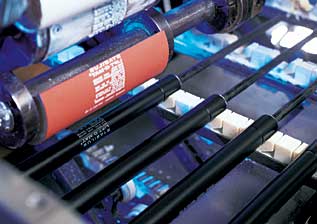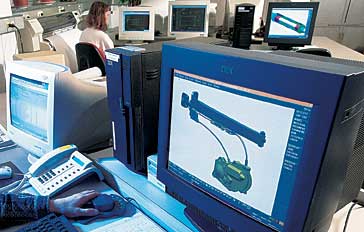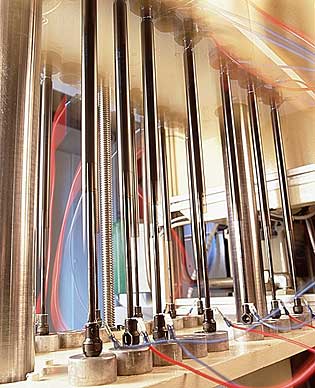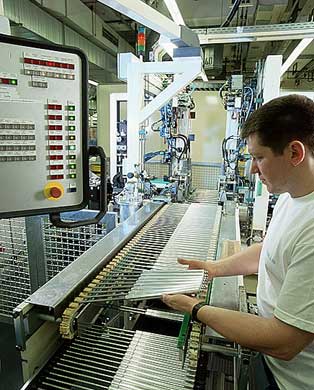Spring time
Stabilus, the German company that virtually created the gas spring industry when it started producing pistons in gas-filled tubes in the early 1960s, has recently branched out in a new direction: stainless steel.
Summary
Stabilus products are sold by local representatives throughout the world. For industrial applications in Scandinavia, Britain and France, that role is taken by SKF’s Linear Motion division. It’s part of SKF’s policy of offering its customers complete solutions to their engineering problems. Fredrik Adlercreutz, SKF Linear Motion sales manager for Sweden, says that in some cases Stabilus’ springs and SKF’s actuators can be used together — “for example, to raise a table, where the spring can provide extra power and the actuator precise control.” Springs, he notes, are often cheaper and smaller, because there’s no gearing and no motor, but they lack the precise control of an actuator. Stabilus’ Andreas Wolf, responsible for the relationship with SKF in Britain and Scandinavia, points out that even where the two items cannot be used together, many customers need both for different functions in a single product. “In a wheelchair, for example, you might have an actuator to adjust the height and a spring to adjust the back rest,” he says.
Wolf says the partnership with SKF, which goes back 20 years, “is one of the most successful we have.”
It’s hard to imagine, but there was a time only 40 years ago when you had to turn the seats of office chairs around and around until they reached the right height. Flaps covering inspection hatches on machines used to be kept open by metal rods. You had to situate the rod in the hole, otherwise you had to hold the flap up with one arm to stop it from falling on your head while you examined the machine.
Stabilus, based in the German city of Koblenz on the Rhine, put a stop to that with the gas spring. “The idea of a gas spring goes back to the 19th century, but it was Stabilus that worked out how to make them in industrial quantities,” says marketing manager Berndt Sander. Now the company has produced more than 1.5 billion of the devices, and it continues producing 100 million a year, in 10 factories in as many countries around the world.
A gas spring is a piston in a gas-filled tube. Although the pressure throughout tube is the same, the top end of the piston has a larger surface area than the one attached to the piston rod, so the gas tries to push the piston out. Take, for example, the spring used in helping a car’s tailgate to rise. When the trunk lock is released, the gas pushes the piston, opens the spring and raises the lid. When someone pushes the lid down, a force is applied to the spring and the piston is pushed back in.
By calculating exactly the forces applied to the piston rod, one can define the precise characteristics of the spring. There’s a hole in the piston to let the gas through. Depending on its size, the movement of gas from one side of the piston to the other will be restricted, resulting in a faster or slower response to the force applied. This type of spring is also likely to contain oil to dampen the movement, especially at its extremities. “That provides a hint of luxury and high quality,” says Sander.
A wide variety
Andreas Wolf, area sales manager for industrial applications, says the process is extremely complex. “Every spring is different, and it’s the calculation of all the various factors in a spring that is our expertise,” he says. The company has 15,000 product variants, but these are carefully defined combinations of a far smaller number of more or less standard pressure tubes, piston rods, pistons, connecting elements and other parts. In addition, every application will have its own gas pressure and its own dampening characteristics. “One of the reasons we’re market leaders is we know how to manage these combinations,” Sander says.
Individual orders might be quite small, but because the elements used will be produced in huge numbers, the price can remain competitive. “We may produce a spring to raise and lower a particular limited line of hospital beds,” Sander says. “But the parts used in that spring may also be used by the millions in the auto industry.”
In addition to Stabilus’ standard Lift-O-Mat, used in tailgates, there’s the Bloc-O-Lift, which allows movement to be stopped at any stage and is typically used to adjust a seat back. Then there are the Stab-O-Mat and Stab-O-Bloc, which provide variable height adjustment for chairs and are designed to deal with the bending that occurs when people move around in the seats. Finally there are two newer products, the Dorstop, which allows car doors to be securely opened to any point, and the Stab-O-Focs, an electrically driven opening and closing system for flaps.
Now the Lift-O-Mat is available in stainless steel. The new Inox-Line spring was designed to meet a specific need, Wolf says. “We were often asked to produce springs in stainless steel,” he says. “In industry there are sometimes very high demands for surface quality, corrosion resistance, hygiene and non-magnetic qualities, but we always said ‘no.’ You need special skills and special tools to produce in stainless steel.”
Stainless steel
But in 2000, Stabilus bought a small manufacturer that had a special line of stainless steel springs. Stabilus combined its know-how with that of the newly acquired company and started producing stainless steel springs using Stabilus’ modular concept. “They’re all made in that factory because you have to have a dedicated production line, since a single shaving of iron in the machines will make stainless steel rust,” Wolf says. “And anyway, they have the skill in working with this very difficult material. You have to use special tools and techniques; you can’t even touch the surface without gloves.”
Because Stabilus has introduced its modular approach, the new springs are available at a competitive price. “It’s still two or three times more than ordinary iron,” Wolf says. “But for special uses, it’s often worth the extra.” Sander lists some areas where stainless steel can be an advantage: “It can be used in industrial composting plants where you have heavy metal covers and aggressive gases, magnetic resonance machines where you can’t allow magnetic materials, hospital beds that are cleaned with steam and chemicals, on ships where it’s more resistant to salt water, or in the food industry, since it can be kept hygienically clean.” In the past, stainless steel could be so expensive that people simply did without the spring and used another solution. Stabilus has made stainless steel springs affordable.
Wolf believes that stainless steel is a growth area. “It’ll remain a limited part of our production,” he says. “But we see it as one of the fastest-growing areas in the business. So far we’re only making the Lift-O-Mat Inox-Line in a limited range, but that might change soon. We’re keeping an eye on the market.”
When you’re already a market leader, it’s a bit of a problem finding new ways to grow. By taking on the challenge of stainless steel, Stabilus is showing it’s not prepared to rest on its laurels.










